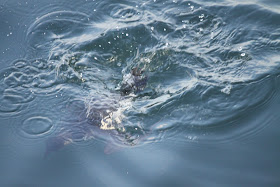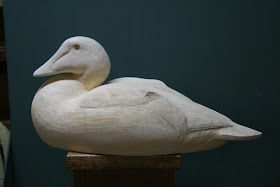These decoys, although based on realistic features are stylized a bit introducing artistically interpretive relationships and proportions instead of measurements. The decoys were carved from tupelo and hollowed with exotic wood appointments added to the bottom insert plates and carved keels.
Drake Shoveler, rough carved-
Because the wing tips were raised high and undercut substantially, I added hardwood wingtip sections that were reinforced with small brass rods and then epoxied in place. For the hardwood, I used Bulletwood (Manilkara bidentata)-
For the exotic wood insert plate on the bottom of the decoy, I used Macadamia wood-
The sanded decoy-
To continue the Central American feel, the keel was carved from figured Mango wood-
Sealed one coat-
Primed with several coats of Flake White Japan oil paint-
The Shoveler decoy painted in Grisaille using Black, White and Gray-
For this decoy, I decided to paint all the dorsal areas first with the exception of the head and bill. All the basic colors and blends were added including the Phthalo Green highlights on the tertials, scapulars and upper tail coverts. Also painted were the long blue scaps and the white lateral scapulars including setting up any vermiculation or markings within these feathers-
This drake Shoveler had a small area of the wing exposed. I painted the green secondaries, white greater secondary coverts, and the blue values of the medial and lesser coverts-
The remainder of the decoy was painted and blended also setting up any feather details which will be painted when the paint is tacky: white flanks, side pockets, chest and head/bill-
Finishing the details. Many values of Green were added to the head painting. The black bill was highlighted with soft grays and blue/greens completing the color dynamic of the plumage.-
Subtle vermiculations added to the upper margin of the side pockets and the white lateral scapulars-
The finished drake Shoveler-
A hen to compliment the drakes-
Fork-tailed Flycatcher- I carved this Tropical Flycatcher for a fund raiser for the Conn. Ornithological Assoc. This bird was carved as a decoy like the Exotic Species (Toucans, Macaws, Quetzals, Guans, Toucanets, etc.) I carve and bring with me to Costa Rica. It is carved from tupelo, and the long tail has small dia. brass rods inserted for strength.-
Carved-
Primed with Gray Japan Oil-
Grisaille-
The tail and wing is painted. The feathers are located and blended, the details will be painted later when the paint is tacky-
The completed Fork-tailed Flycatcher-
Drake Wigeon-
Rough carved decoy. The lower mandible is inserted and carved from Holly. The tongue was also carved separately and glued into the lower mandible before both were pinned and glued into the head blank.-
After the feather groups and individual feathers were delineated and carved, the decoy was sanded smooth, hollowed, bottom plate and keel added, and then sealed with one coat of satin Deft sealer-
The Wigeon painted completely in Grisaille, ready for painting-
For this drake Wigeon, I completely painted the head first. It was easier to paint the head while the body was free of paint. This allowed a better hold when I handled the decoy for the long hours it took to paint the head. Just as in the Gadwall painting from the previous page, the basic feather layout and multiple colors of the body were added and blended allowing many hours of paint manipulation before it was set aside to get tacky. I used Titanium White Old Holland and Permalba Soft White oil paint to insure a long working time and a longer drying time. This allowed me to work the paint for a day or two before it was set aside to tack.
The body colors of a drake Wigeon have more color recipe combinations used by many carvers. I like to mix many variations of the body colors by mixing varying amounts of the following colors: For the side pockets- Raw Sienna, Burnt Sienna, Dioxazine Mauve, Magenta,White and a little Ultramarine Blue deep. For the scapulars, introduce Burnt Umber and Cadmium Red Light. For the chest, add more Magenta, Violet, Burnt Sienna and Cadmium Red Light.-
The body of the Wigeon has been completely painted adding feather groups, feathers and varying color values of all the areas-
When the paint was tacky (three to five days), I painted all the feather details and vermiculations. The final small details and color values were added to the head both on the small dark spots and the lighter values in between these small dark spots-
The finished decoy-
Finished decoy-
"Blue morph" Ross' Goose. Rough carved-
Completely carved and sealed. (the yellow glow is caused by the light bulb)-
Finished decoy-
Drake Mallard. Just the beginning carving steps-
Carved, sanded and sealed, ready to be primed. The wingtips and "curl" were inserted Holly-
Primed with Gray Japan paint-
Finished decoy-
Drake Black Duck in a cold weather relaxed pose-
Having fun with a few Alcids and Sea Birds. I love Alcids and Seabirds and they are among my favorite birds to watch and carve. I photographed this Common Murre in January 2011 off Madison, CT. It was found by another CT birder, and I happened to be in the right place at the right time. The Murre swam close to me near shore and I was able to take many images of this bird. This Common Murre was the first documented sighting of this species in CT waters.-
To commemorate this bird and this sighting, I wanted to carve a decoy of it. So I drew the pattern just like I saw the bird as it swam by. Here is the rough carved Common Murre-
Sanded and sealed-
Razorbills are common along the New England coast. They breed on many of the outer northern Islands off the Maine coast. They pass by all the New England coastal states during their winter southern migration. They are commonly seen off the coasts from November to March. Alcids have two distinct plumages....summer and winter plumage. This adult Razorbill below is in breeding plumage. It was photographed in July-
This juvenile Razorbill is dressed in its first winter plumage. Adults in winter have the same plumage. Their normally dark head is replaced by the soft white and gray throat and cheeks with the small auricular stripe behind the eye. Alcids and diving Seabirds use their whole wings to swim or "fly" under water when they dive for fish. This posture below with the Razorbill holding its wings outside the body is a common posture-
I carved this Razorbill in the classic Alcid pose with the wings outside the body ready for a dive. I carved the wings separately and inserted them. The adult Razorbill decoy carved and sealed ready for paint.-
The finished Common Murre........
.....and adult Razorbill in winter plumage. (For summer duty, I repainted this decoy in breeding plumage- as seen below in the floating decoy images with the Atlantic Puffin)-
Winter Razorbill lumage painting-
Common Murre-
Black Guillemot is another favorite Alcid species of mine. It is very common off the coast of Maine and can be seen just about anywhere along the Maine coast. It also migrates in the fall, with smaller numbers visible along the coast north of Cape Cod. Here is the Black Guillemot in summer breeding plumage.....
.....and in winter. I photographed this Black Guillemot in Rhode Island in December 2010. It is rare in Rhode Island-
Summer breeding plumage Black Guillemot carved, sanded sealed and primed black ready for paint. I carved this Guillemot from Maine White Cedar-
The bottom wood plate was carved from Mahogany and the carved keel from White Oak. Both wood pieces were driftwood I found in Maine a year earlier. I cut them to size and used them on this decoy.-
The tail, upper tail coverts and primaries were painted first. I used a bit of alkyd oil Black and White paint on this decoy. I wanted it to dry quicker and have that egg shell finish typical of classically painted decoys-
The tertials and secondaries were painted next-
Followed by the White shoulder coverts-
The scapulars and side pocket areas were painted with a dark medium Brownish/Gray. I followed with Black outlined feathers. When the feathers were completed, I soft blended them into the gray using a flat red sable brush.-
The balance of the decoy was painted black (with a small amount of Raw Umber added)-
The completed decoy-
The small group of Alcid decoys: Atlantic Puffins, Black Guillemot, Common Murre and Razorbills (Puffin on the left is real)-
One of my absolute favorite Seabirds and favorite bird species; the Red-billed Tropicbird-
The carved decoy, hollowed, sanded and sealed. The tail streamer is inserted Bulletwood. This wood is incredibly strong and is very hard to break.-
Since the Red-billed Tropicbirds that are seen off the North Carolina coast and extremely rarer off the New England coast come from Bermuda and Caribbean waters. To appropriately detail this decoy, I used two spectacular Caribbean wood species for the wood plate and carved keel. The bottom plate was made from spalted Tamarind (Tamarindus indica) and the keel from Chechen wood (Metopium brownei).-
With the decoy painted, the details were added-
The completed Red-billed Tropicbird-
Floating......
.....and a decoying Red-billed Tropicbird! (Tropicbird upper left- my decoy lower right)-
A few Gannets and Fulmars I am carving to be added to my pelagic birding rig. Tupelo with Mahogany and Teak bottom boards-
A few more sea bird decoys I added for summer pelagic birding trips: Pomarine Jaeger, Sabine's Gull, White-faced Storm Petrel, Leach's Storm-Petrel, Audubon's Shearwater, (the Greater Shearwater already carved) and a Bridled Tern standing n a floating buoy.-
November Pelagic rig (from rear left counter clock-wise to right): Great Skua, Greater Shearwater, Puffin, winter Razorbill (Crowell style), winter Thick-billed Murre (Crowell style), Common Murre, winter Dovekie (Crowell style), Common Murre (Crowell style), winter Razorbill, Black-legged Kittiwake, winter Puffin (Crowell style) and Pomarine Jaeger-
From front to back: winter Razorbill, winter Razorbill (Crowell style), Common Murre, Common Murre (Crowell style), Thick-billed Murre (Crowell style), winter Dovekie (Crowell style), Puffin and winter Puffin (Crowell style)-
A few more "before and after" shots. Pair of Labrador Ducks "rough carved"-
Finished hen-
Drake-
Pair-
Pair Oldsquaw-
Completely carved drake ready to be sanded and finish the details. The long scaps are inserted Holly, and the tail is inserted Bulletwood-
Hen Oldsquaw, carved and ready to be sanded and detailed-
Sanded and sealed-
Primed-
Initially, I painted the tail and primaries and bended all the feathers on the wings and scapuylars of the hen. This feathering is the first steps in color "hopscotching" before it is set aside to tack up for the details-
The painting continued on the dorsum, chest and side pockets of the hen, and the chest, dorsum and the head of the drake-
When they were tacky, the long process of detailing began-
All the body painting is completed. All that was left was to paint the bills-
Finished Oldsquaw pair-
Black-bellied Whistling Duck, carved, sanded and sealed-
The two wood species used for the bottom plate and keel are: Mayan Walnut (Lysiloma bahamensis) for the bottom plate, and Sapodilla (Manilkara zapota) for the keel, both species are from Mexico through the Caribbean Islands.-
Service Common Eider pair. These decoys were carved in courtship poses.-
Primed-

Finished pair-
"Smoothie" drake Red-breasted Merganser-
drake Wood Duck-
I included a few images from a large decoy collection from a Collector of mine. He has over five hundred of my decoys in his collection and his collection includes a mix of contemporary and classic styles with all species of Waterfowl, Shorebirds and Seabirds represented. He started collecting my decoys in the early 1980's-
The Swan was carved by him-
The Canada Geese, Snow Goose, Wood Duck, Mallards and Brant on the second and third shelves were carved by John McLaughlin-
Keith Mueller
Killingworth, CT


































































































.jpg)





















































































































































